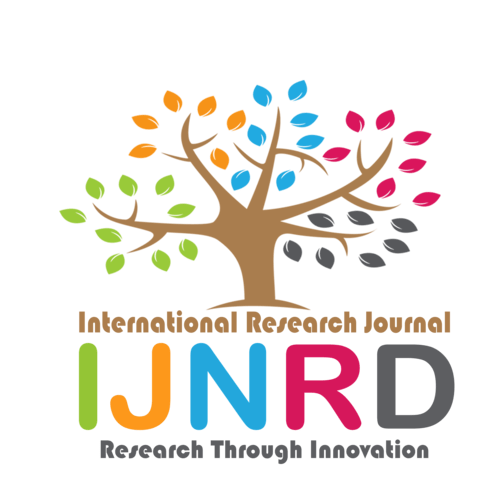|
|||||||||||||||

|
INTERNATIONAL JOURNAL OF NOVEL RESEARCH AND DEVELOPMENT International Peer Reviewed & Refereed Journals, Open Access Journal ISSN Approved Journal No: 2456-4184 | Impact factor: 8.76 | ESTD Year: 2016 Scholarly open access journals, Peer-reviewed, and Refereed Journals, Impact factor 8.76 (Calculate by google scholar and Semantic Scholar | AI-Powered Research Tool) , Multidisciplinary, Monthly, Indexing in all major database & Metadata, Citation Generator, Digital Object Identifier(DOI) |
||||||||||||||
Issue: May 2024
Volume 9 | Issue 5
Review Result and Publication of Paper within : 2-3 days
Click Here For more DetailsFor Authors
Forms / Download
Published Issue Details
Editorial Board
Other IMP Links
Facts & Figure
Impact Factor : 8.76
Issue per Year : 12
Volume Published : 9
Issue Published : 96
Article Submitted :
Article Published :
Total Authors :
Total Reviewer :
Total Countries :
Indexing Partner
Join RMS/Earn 300
Licence
This work is licensed under a Creative Commons Attribution-NonCommercial 4.0 International License







|
Published Paper Details
|
|
| Paper Title: | Comparative Study to Assess the Efficacy of Intrapleural Corticosteroids versus Systemic Corticosteroids in the Treatment of Tubercular Pleural Effusion |
| Authors Name: | Dr Sourabh Phutela , Dr Kiranjit , Dr Raj Kumar , Dr Kuldeep Singh , Dr Husan Pal |
| Download E-Certificate: | Download |
| Author Reg. ID: |
IJNRD_189230
|
| Published Paper Id: | IJNRD2303297 |
| Published In: | Volume 8 Issue 3, March-2023 |
| DOI: | |
| Abstract: | Background: Tubercular Pleural Effusion is the second most common extrapulmonary site of involvement after lymph node tuberculosis. It is basically due to the type IV hypersensitivity reaction leading to the inflammation of the pleura. The healing of effusion arises with a legacy of pleural fibrosis resulting in clinically relevant pleural thickening and impairment of lung function. Corticosteroids have been shown to play an important role in treating and preventing pleural fibrosis when used along with ATT therapy in cases of Tubercular Pleural Effusion. Commonly corticosteroids are prescribed as oral/systemic therapy. Some studies have also shown that a single dose of intrapleural application of corticosteroids reduces complications like pleural fibrosis. Thus, this study was conducted to compare the efficacy of intrapleural corticosteroids versus systemic corticosteroids in the treatment of tubercular pleural effusion. Methods: A total of 100 patients with tubercular pleural effusion who presented to the Department of Pulmonary Medicine, GGSMCH Faridkot were included in the study for one year. Using a computer-generated random number table cases were randomised into two groups, Group I and Group II. Both groups were given Anti Tubercular Treatment (ATT) Fixed Dose Combination (FDC), according to the weight band as per National Tuberculosis Elimination Program (NTEP) guidelines. In addition to ATT, Group I was given Tablet Deflazacort P.O. 0.75mg/kg/day for 6 days thereafter tapering the drug 0.6mg/kg/day for 6 days 0.45mg/kg/days for 6 days 0.3mg/kg/day for 6 days 0.15mg/kg/day for 6 days stopped. In Group II, at the time of therapeutic aspiration, Intrapleural application of Dexamethasone 8mg, single time, was done. After this, patients of both groups were followed up at 4 weeks, 8 weeks, 12 weeks, and 24 weeks with chest x-rays and USG chest to estimate the level of pleural fluid (resolution/increase in pleural effusion) and pleural thickening (fibrosis/adhesions). Results: At the end of the study period, it was seen that a maximum of the patients (group I -- 64% and group II – 66%) showed resolution of pleural effusion during the first 8 weeks of treatment (not significant), whereas in 14% of the patients in group I and 4% in group II, pleural effusion did not resolve till the end of the study period (not significant). Residual Pleural Thickening was seen in 28% of patients in group I and 32% in group II (not significant). But more side effects of drugs were seen with oral corticosteroids (78%) than with intrapleural corticosteroids (40%) with a significant p-value. Conclusion: Keeping in view the fewer side effects of local corticosteroids, we emphasize that Intrapleural corticosteroids should be considered over Oral corticosteroids along with Anti- Tubercular Therapy in the treatment of Tubercular Pleural Effusion. |
| Keywords: | Tubercular pleural effusion, oral corticosteroids, intrapleural corticosteroids, residual pleural thickening |
| Cite Article: | "Comparative Study to Assess the Efficacy of Intrapleural Corticosteroids versus Systemic Corticosteroids in the Treatment of Tubercular Pleural Effusion", International Journal of Novel Research and Development (www.ijnrd.org), ISSN:2456-4184, Vol.8, Issue 3, page no.c847-c851, March-2023, Available :http://www.ijnrd.org/papers/IJNRD2303297.pdf |
| Downloads: | 000118763 |
| ISSN: |
2456-4184 | IMPACT FACTOR: 8.76 Calculated By Google Scholar| ESTD YEAR: 2016 An International Scholarly Open Access Journal, Peer-Reviewed, Refereed Journal Impact Factor 8.76 Calculate by Google Scholar and Semantic Scholar | AI-Powered Research Tool, Multidisciplinary, Monthly, Multilanguage Journal Indexing in All Major Database & Metadata, Citation Generator |
| Publication Details: |
Published Paper ID:IJNRD2303297 Registration ID: 189230 Published In: Volume 8 Issue 3, March-2023 DOI (Digital Object Identifier): Page No: c847-c851 Country: FAZILKA , Punjab , India Research Area: Health Science Publisher : IJ Publication Published Paper URL : https://www.ijnrd.org/viewpaperforall?paper=IJNRD2303297 Published Paper PDF: https://www.ijnrd.org/papers/IJNRD2303297 |
| Share Article: | |
|
Click Here to Download This Article |
|
| Article Preview | |
|
|
|
Major Indexing from www.ijnrd.org
| Semantic Scholar | Microsaoft Academic | ORCID | Zenodo |
| Google Scholar | ResearcherID Thomson Reuters | Mendeley : reference manager | Academia.edu |
| arXiv.org : cornell university library | Research Gate | CiteSeerX | PUBLON |
| DRJI | SSRN | Scribd | DocStoc |
ISSN Details
 |
 |
ISSN: 2456-4184
Impact Factor: 8.76 and ISSN APPROVED
Journal Starting Year (ESTD) : 2016
DOI (A digital object identifier)
Conference
Open Access License Policy
Important Details
Social Media
| Copyright © 2024 - All Rights Reserved - IJNRD |












Facebook Twitter Instagram LinkedIn